#spiralia
Text
Taxonomy Tournament: Gastropods

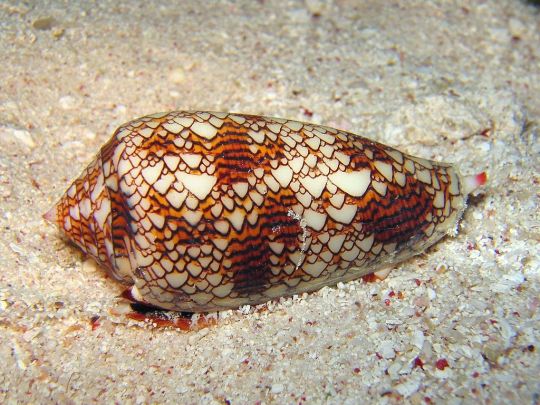
Strombidae. This family is made up of true conches, which have long eye-stalks and move in a leaping motion, and are used by humans as food, or their shells for decoration.
Conidae. This family is made up of cone snails, which hunt prey by launching their tooth from their mouth like a harpoon and injecting them with venom.
#animals#biology#polls#poll tournament#zoology#conches#gastropods#molluscs#spiralia#cone snails#Strombidae#Conidae#0x59v0xa6#animal tournament#Animal Tournament Round 1
625 notes
·
View notes
Text
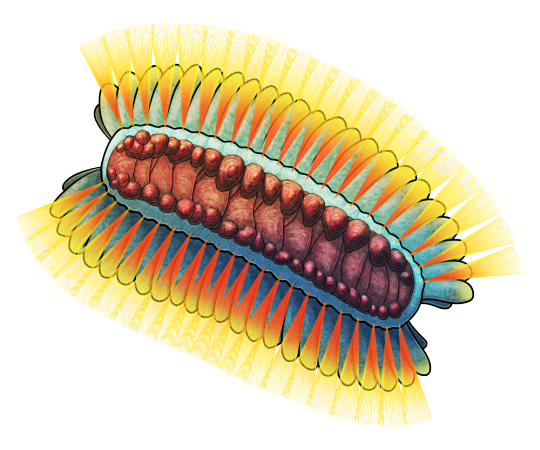
Strange Symmetries #02: Oh Worm
Living during the Cambrian Period about 518 million years ago, Wufengella bengtsonii was discovered in the Chinese Chengjiang fossil deposits and was recently named and described in late 2022.
It was a small worm-like animal about 1.6cm long (~0.6"), with bundles of long bristles along its sides and flap-like structures on its underside. Its back was also covered with sclerite armor arranged in a strangely asymmetrical fashion, with larger overlapping plates in the middle and numerous smaller cap-like sclerites distributed unevenly along each side.
Although its bristles and appendages resemble those of annelid worms, the distinctive structure of the sclerites identifies Wufengella as being a member of the tommotiids – early relatives of modern lophophorates (bryozoans, brachiopods, and horseshoe worms).
Its discovery actually confirms an old prediction that lophophorates probably originated from armored worm-like animals, representing an evolutionary link between earlier free-living annelid-like forms and later immobile filter-feeding tommotiids.
It's not known why the armor on Wufengella's back was so unevenly organized – but some of the later tube-like tommotiids also had weird symmetry going on, with forms like Eccentrotheca having irregular sclerites arranged in a spiral around their bodies.
———
NixIllustration.com | Tumblr | Twitter | Patreon
#science illustration#strange symmetries#paleontology#paleoart#palaeoblr#wufengella#camenellan#tommotiida#lophophorata#lophotrochozoa#spiralia#invertebrate#art#oh worm
172 notes
·
View notes
Text
I GOT NO SLEEP
LOST MY MIND
I HOPE IM DREAMING THIS TIME
2 notes
·
View notes
Text
I think that covers it. Didnt include Annelids bc im still deciding what worms can be anthroed. Been so hard to decide what to focus on!
You can also comment specific animals!
5 notes
·
View notes
Text
Intro and Sophont List
This is a DnD rehaul inspired by @danbensen's Fellow Tetrapod story.
All races and classes available to DnD 5e will be reinterpreted as a sophont according to his guide for making FT sophonts. (Skill trees will be available for each sophont species).
Sophonts currently in FT will not be added until the current workload is complete. Sophont list below, although it's a heavy WIP.
Humans (Human, Hominid)
Noxissum (Aaracrocka, Pelagornis) -> thrill-seeking sophonts that live on cliffsides
Volutor (Aasimar, Polyneoptera)
Fixers [of Flesh] (Autognome, Canis) -> climbing oophagous sophonts with a focus on hunger
? (Bugbear, Barbourofelidae)
Harvau (Centaur, Mesohippus)
? (Changeling, Coleoidea)
Hemadele (Dhampir, Geospiza) -> blood-drinking sophonts that trade themselves for food
Deager (Dragonborn, Toxicofera) -> artistic sophonts with sprayed venom that dyes
Korrines (Dwarf, Herpestoidea) -> burrowing sophonts with deep familial bonds
Helbosi (Elf, Acariformes)
? (Fairy, Microraptoria)
? (Firbolg/Giant/Goliath, Pecora)
? (Genasi, Spiralia)
Breakers [They that Break the Waves] (Gnome, Otariidae)
? (Goblin, Holocephali)
? (Halfling, Callitrichidae)
? (Kenku, Corvides)
? (Kobold, Isoptera)
6 notes
·
View notes
Text
Ma rétrospective Soundcloud 2023 😊 (et oui, je suis aussi sur Soundcloud 😁
Totalement différente de celle de Spotify 😂


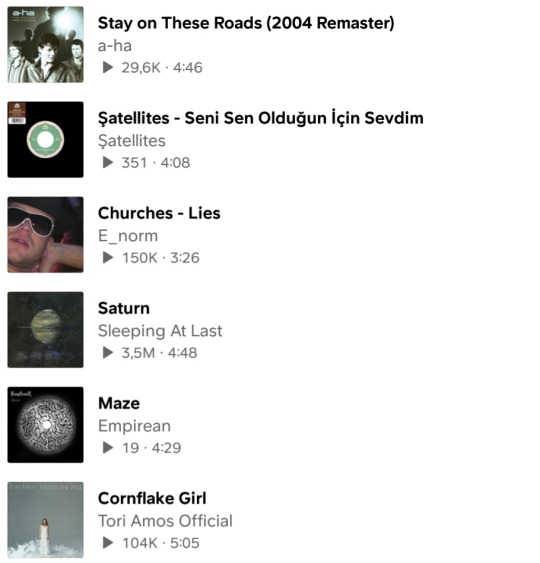



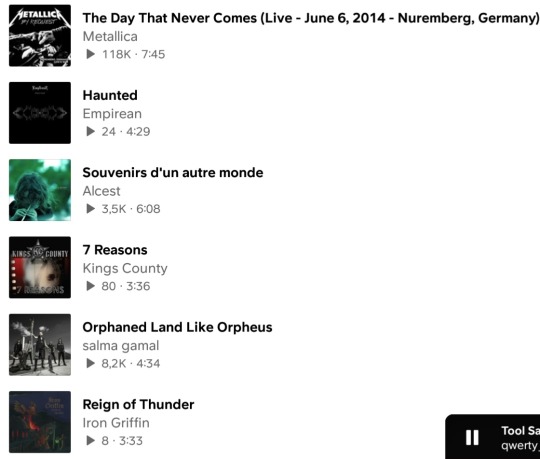


2 notes
·
View notes
Text
A quick overview of plants and animals of Varin
Plants of Varin
The plants of Varin, like the plants of Earth, are green. The land plants of this world belong to four main groups; Spiralia, Titanica, Limia, and Aenigma.
Limia are the most primitive and were likely the first plants to colonize land. They are relatively small, all less than a foot high, and inhabit moist environments. They are reminiscent of moss, with short “bulbs” of leaves growing from a central body. When they reproduce, they secrete a thick slime from their bulbs that contains sperm and eggs. They lack any kind of support structure or vasculature. Thick carpets of them can be found around bodies of freshwater.
Spiralia are the most diverse group of plants. Named for the distinct spiral of leaves that branch off the stem, they are quite beautiful and elegant-looking. They include the grass-like plants that cover the plains and savannas of Varin, medium-sized shrubs and bushes in the undergrowth of forests, and brilliantly colored flowering organisms. The largest species include the tree-like varieties that dominate forests, supported with a chitinous trunk that seems to grow quickly the first few years of life and then stop, capping the size of the tree at about 60 feet. The reproductive slime of these plants is sweet-tasting and nutritious, and many species package it inside fruiting bodies. These make up the vast majority of crops in the Doulori diet.
Titanica plants are named for their impressive size. Although not a very diverse group, these are the tallest tree-like plants of the Varin ecosystem. With a stiff yet flexible trunk made from a chitinous cortex, these trees continue growing throughout their whole lives and can attain sizes of 300 feet tall and 20 feet in diameter, rivaling the largest trees on Earth.
The Aenigma are named for their cryptic nature. They are massive plateaus of plant life supported by several trunks, growing up to a mile long and up to a hundred feet high. They seem to be most closely related to the Limia, and are composed of many small plants rather than one single organism. These massive creatures can dominate ecosystems. The habitats created by these plants are called Labyrinth Forests.
Animal Phyla of Varin
Amorpha: Ancient, salp or jellyfish-like organisms. Found in oceans worldwide. Predators or filter-feeders.
Hexapods: Organisms with 6 limbs and an exoskeleton. Highly diverse, found in marine, freshwater, and terrestrial ecosystems. Includes megafaunal varieties such as the gigantic, oceanic paddle-snakes and the giant land crabs of Kana.
Tubiforms: This is not one phylum but several, united by their worm-like body shape. Very understudied. Found in marine, freshwater, and terrestrial ecosystems.
Psuedochordates: Small mollusk-like animals related to the Mollichordates. Primarily found in and around marine and freshwater habitats, but a few can be found inland.
Mollichordates: The large, dominant animals of Varin. These are what I will be primarily focusing on in this study.
Itchyomorpha: These are animals that have evolved to be remarkably fish-like in appearance, with fully internal cartilaginous skeletons and advanced jaws. They seem to have once been much more diverse. There are many marine species and some freshwater.
3 notes
·
View notes
Text
Phylogenomics suggests that larvae are ancestral in polyclads, but not homologous to the trochophore
Platyhelminthes (flatworms) are a diverse invertebrate phylum that are useful for exploring life history evolution. Within Platyhelminthes, only two clades develop through a larval stage: free-living polyclads and parasitic neodermatans. Neodermatan larvae are considered evolutionarily derived, whereas polyclad larvae are hypothesized to be retained from the last common ancestor of Platyhelminthes - and Spiralia - due to ciliary band similarities among polyclad and other spiralian larvae. However, larval evolution has been challenging to investigate within polyclads due to low support for deeper phylogenetic relationships. To investigate polyclad life history evolution, we generated transcriptomic data for 21 species of polyclads to build a well-supported phylogeny for the group. We then used ancestral state reconstruction to investigate ancestral modes of development (direct vs indirect) within Polycladida, and flatworms in general. The resulting tree provides strong support for deeper nodes and we recover a new monophyletic clade of early branching cotyleans. Early branching clades of acotyleans and cotyleans possess diverse modes of development, suggesting a complex history of larval evolution in polyclads that likely includes multiple losses and/or multiple gains. Our ancestral state reconstructions in previous platyhelminth phylogenies also suggest that larval similarities between flatworms and other phyla are most likely convergently evolved http://dlvr.it/STwnRs
0 notes
Photo
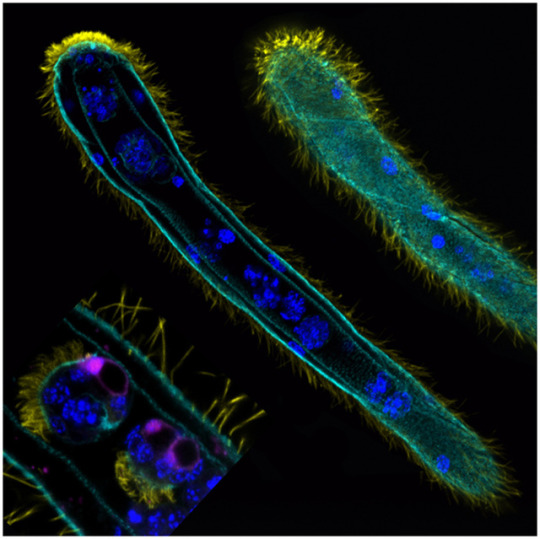
Lessons on Parasitism from the Curious Dicyemida
Research in Genome Biology and Evolution has looked to the “decidedly curious” Dicyemida in attempt to answer an important question: how has parasitism evolved?
Found in the renal sacs of both squid and octopus, this microscopic organism derives nutrients from the host’s urine and has been categorised within the group Spiralia, along with flatworms and molluscs.
Using sequencing technologies to analyse the genome of Dicyemida, researchers sought to provide further insight into this “odd organism” and revealed that, like other parasites, it has a reduced genome, with only ~5,000 genes.
Find out more about the strange Dicyemida and what effect this loss of genetic material has on its fundamental functions.
#Genome biology and Evolution#evolutionary biology#mesozoa#genomic analysis#microscopic organisms#life science#oxford university press#oxford journals#spiralia#dicyemid#hox genes
42 notes
·
View notes
Text
Taxonomy Tournament: Cephalopods


Sepiida. This order is made up of cuttlefish, which have an internal shell called the cuttlebone that is used to control buoyancy.
Nautilida. This order is made up of nautilis, which have a unique planispiral shell, and move via jet propulsion. They're morphologically veyr similar to their ancient relatives, and are often called living fossils.
#animals#biology#polls#poll tournament#zoology#cuttlefish#molluscs#cephalopods#spiralia#nautilis#Sepiida#Nautilida#0x29v0x56
223 notes
·
View notes
Photo
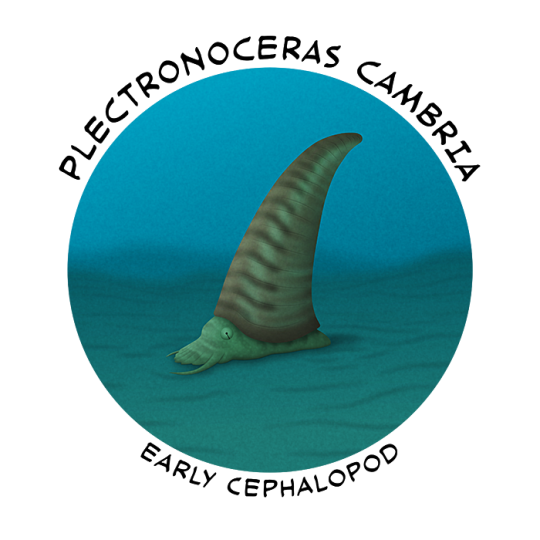
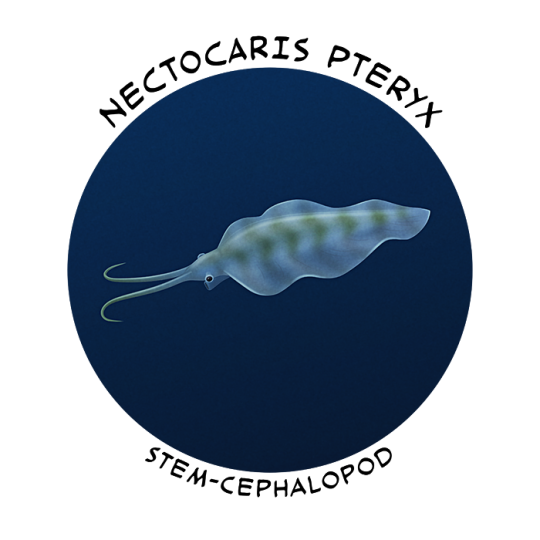
Cambrian Explosion Month #26: Phylum Mollusca – Tentacle Time
Cephalopods' highly distinctive body plan and incredible intelligence make them some of the most charismatic marine animals. Today they're mainly represented by the soft-bodied coleoids (octopuses, squid, and cuttlefish), with the modern giant squid and colossal squid being the largest living invertebrates. In comparison the shelled nautiluses seem like weird oddballs, but they're actually far more typical examples of the group than their squishier cousins – as part of the conchiferan lineage the ancestors of all modern cephalopods were also shell-bearing molluscs, and for much of their evolutionary history shelled forms like ammonites and orthoceridans were extremely abundant.
The exact evolutionary relationships of cephalopods within the conchiferan family tree aren't clear, but their closest relatives might be modern monoplacophorans and they probably descended from limpet-like "monoplacophoran-grade" ancestors in the early Cambrian. The current oldest potential cephalopod fossils come from about 522 million years ago, but the first definite cephalopods in the fossil record come from much later in the period.
Plectronoceras cambria was a tiny early nautiloid, known from the Late Cambrian of eastern China (~490-485 million years ago). Its shell was about 2cm long (0.8") and it had the characteristic features of cephalopod phragmocones – chambers, septa, and a siphuncle.
This suggests it had internal air spaces reducing the density of its shell and acting as a buoyancy control mechanism, but its shell shape also indicates it wasn't adapted for jet-powered swimming like later cephalopods. Instead it may have mostly crawled around on the sea floor, while also being able to float up vertically into the water column either to avoid predators or to access new food sources.
———
But there's a complication in the simple-seeming story of shelled ancestral cephalopods learning to float, and its name is Nectocaris pteryx.
Known from the Canadian Burgess Shale fossil deposits (~508 million years ago), the Australian Emu Bay Shale (~514 million years ago), and the Chinese Chengjiang fossil deposits (~518 million years ago), this animal had a surprisingly squid-like body with fleshy fins, two tentacles, stalked eyes, a siphon-like funnel, and no sign of a shell.
It also came in two different "size morphs", one about 3cm long (1.2") and the other about 10cm long (4"), which might represent sexual dimorphism.
For a long time it was known from only a single incomplete fossil from the Burgess Shale, with uncertain classification and strange-looking attempted reconstructions. But in 2010 many more better-preserved fossils revealed that Nectocaris seemed to be some sort of early soft-bodied cephalopod, pre-dating early nautiloids like Plectronoceras by almost 30 million years.
It's generally thought to be a member of a short-lived stem lineage that diverged early on in the groups' history, convergently losing their shells and developing a resemblance to modern coleoids – a sort of early "experiment" in coleoid-like fast active swimming, but which ultimately failed and didn't happen again until the true coleoids evolved a couple of hundred million years later.
…Except there's now yet another twist.
The recently-discovered Nectocotis rusmithi is a nectocaridid from Late Ordovician deposits in the state of New York, USA, dating to about 450 million years ago. It demonstrates that these early cephalopods survived for much longer than previously thought, and even made it through the end-Cambrian extinction event that wiped out all but one lineage of the shelled cephalopods.
And it had an internal shell – but made of a tough non-mineralized substance rather than calcium carbonate.
This brings up a couple of interesting evolutionary possibilities:
Nectocaridids might still be a weird early convergently-squid-like side branch of cephalopod evolution that internalized their shells, with Nectocaris losing the shell completely while Nectocotis retained a non-mineralized version.
Or, shells might have actually been non-mineralized (and possibly also internal) from the start in ancestral cephalopods – potentially explaining the lack of earlier Cambrian fossils. Early forms were Nectocaris-like active swimmers with a high metabolic rate, and nautiloids like Plectronoceras evolved from them during the late Cambrian when oxygen levels were dropping and such high levels of activity were less sustainable, developing mineralized external shells with energy-saving passive buoyancy and lower metabolisms.
———
Nix Illustration | Tumblr | Pillowfort | Twitter | Patreon
#science illustration#paleontology#paleoart#palaeoblr#cambrian explosion 2021#cephalopod#mollusc#conchifera#plectronoceras#nautiloid#nectocaris#lophotrochozoa#spiralia#protostome#bilateria#eumetazoa#animalia#art#convergent evolution
116 notes
·
View notes
Note
Explain the starfish situation Hera
SO
there's a major split in existing animal cladistics, being protostomes and deuterostomes
protostomes include panarthropods, like insects and tardigrades and what have you, and spiralia, which are molluscs like octopi and snails
protostomes form mouth-first
deuterostomes include echidnaderms, which are sea cucumbers, sea urchins, and sea stars, and also CHORDATES
and HUMANS are CHORDATES
9 notes
·
View notes
Text
Phragmoteuthis

By Ripley Cook
Etymology: Fence squid
First Described By: Mojsisovics, 1882
Classification: Biota, Archaea, Proteoarchaeota, Asgardarchaeota, Eukaryota, Neokaryota, Scotokaryota Opimoda, Podiata, Amorphea, Obazoa, Opisthokonta, Holozoa, Filozoa, Choanozoa, Animalia, Eumetazoa, Parahoxozoa, Bilateria, Nephrozoa, Protostomia, Spiralia, Platytrochozoa, Lophotrochozoa, Mollusca, Conchifera, Cephalopoda, Coleoidea, Belemnoidea, Phragmoteuthida, Phragmoteuthidae
Referred Species: P. bisinuata, P. huxleyi, ?P. ticinensis
Status: Extinct
Time and Place: 247 to 190 million years ago, from the Anisian of the Middle Triassic to the Sinemurian of the Early Jurassic.

Phragmoteuthis is known from Austria, England, Germany, and Switzerland.
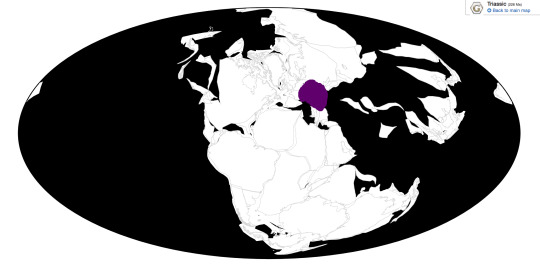
Physical Description: Externally, Phragmoteuthis would have resembled a modern squid. However, it is a member of the now-extinct belemnoids. It had a long mantle, an internal shell, and ten equally-sized hook-bearing arms, none of which were developed into tentacles. Unlike squids, the internal shell of belemnoids had a distinct hollow phragmocone, like earlier Paleozoic cephalopods. This shell also had a long, flat portion anteriorly called a proostracum. The proostractum in Phragmoteuthis was wide and lobed. Posteriorly the shell formed a pointed, horny guard called a rostrum. These rostra are the most commonly found belemnoid fossils. Several specimens of Phragmoteuthis preserve an ink sac, indicating that like most modern cephalopods, it produced a dark ink. Other early belemnoids preserve a pair of rhomboidal fins on the posterior mantle, allowing us to infer the presence of this in Phragmoteuthis.
Diet: It is presumed that belemnoids had similar diets to modern squids, being predators of smaller organisms such as fish.
Behavior: Little is known about belemnoid behavior. Phragmoteuthis was likely an active shallow-water predator, using the hooks on its arms to catch prey such as fish and smaller mollusks. Like all cephalopods, Phragmoteuthis would have been able to propel itself by expulsing water from its siphon. The phragmocone would have helped the animal maintain buoyancy, and the rostrum may have counterbalanced the heavier head region. Ink would have also been expelled from the siphon as a defense mechanism, to confuse potential predators and provide a chance for escape. The frequency of belemnite fossils found implies that belemnites may have been gregarious in life, which could have also applied to Phragmoteuthis.
Ecosystem: Phragmoteuthis lived in coastal areas like most other belemnoids. In fact, one formation that preserves Phragmoteuthis also fossilizes land plants like bennettitales and cycads and insects such as beetles, indicating that that specific spot in Carnian Austria was likely a shoreline. P. bisinuata lived alongside many ray-finned fish such as Sauricthys, Polzbergia, and Thoracopterus, and the other common clade of Mesozoic cephalopods: ammonites, such as Austrotrachyceras. ?P. ticinensis lived alongside ichthyosaurs such as Mikadocephalus and Mixosaurus, pachypleurosaurs such as Serpianosaurus, and more fish, including Gyrolepis, Habroichthys, and Ptycholepis. These ichthyosaurs, as well as large fish, may have fed on Phragmoteuthis, as other belemnoids are sometimes found fossilized inside ichthyosaur and pachycormid guts.
Other: The classification Phragmoteuthis has been contentious - although previously considered an abberant lineage of coleoid cephalopods, more recent authors have considered it an early belemnoid. Some well-known Jurassic species have since been reclassified as the unrelated Clarkeiteuthis. Phragmoteuthids such as Phragmoteuthis are considered transitional between earlier Paleozoic cephalopods and the later, more common belemnites.
~ By Henry Thomas
Sources under the Cut
Doguzhaeva, L., Summesberger, H., Mutvei, H., Brandstaetter, F. (2007). “The mantle, ink sac, ink, arm hooks and soft body debris associated with the shells in Late Triassic coleoid cephalopod Phragmoteuthis from the Austrian Alps”. Palaeoworld 16 (4): 272-284.
Donovan, D. T. “Phragmoteuthida (Cephalopoda: Coleoidea) from the Lower Jurassic of Dorset, England”. Palaeontology 49 (3): 673-684.
Fuchs, D., Donovan, D.T., Keupp, H. (2013). “Taxonomic revision of “Onychoteuthis” conocauda Quenstedt, 1849 (Cephalopoda: Coleoidea)”. Neues Jahrbuch für Geologie und Paläontologie Abhandlugen 270 (3): 245-255.
Fuchs, D., Donovan, D.T. (2018). “Part M, Chpater 23C: Systematic Descriptions: Phragmoteuthida”. Treatise Online 111.
Griffith, J. (2008). “The Upper Triassic fishes from Polzberg bei Lunz, Austria”. Zoological Journal of the Linnean Society 60 (1): 1-93.
Hanlon, R., Vecchione, M., Allcock, L. (2018). Octopus, Squid & Cuttlefish. University of Chicago Press.
Rieber, H. (1970). “Phragmoteuthis? ticinensis n. sp., ein Coleoidea-Rest aus der Grenzbitumenzone (Mittlere Trias) des Monte San Giorgio (Kt. Tessin, Schweiz)”. Paläontologische Zeitschrift 44: 32-40.
#Phragmoteuthis#Squid#Triassic#Mollusc#Palaeoblr#Phragmoteuthis bisinuata#Phragmoteuthis huxleyi#Phragmoteuthis ticinensis#Prehistoric Life#Paleontology#Prehistory#Triassic Madness#Triassic March Madness
154 notes
·
View notes
Text
Sources are provided in link form so that said link can be easily put into the way back machine in case a site is ever taken down.
Huber M. (2010). Compendium of bivalves. Hackenheim, Germany: ConchBooks (Mr. Huber Sir I owe you my life)
Juister Küstenmuseum (no online resources, information taken from the Strandgut section of the museum. I can send you pictures if you speak german) https://kuestenmuseum-juist.de/
Marine species ID portal (good precise descriptions and schematic drawings, but not of everything this blog includes) http://species-identification.org/index.php
Macrobenthos of the North Sea (objectively worse site that the Marine Species ID portal was subsumed into. Use the search at the top of the page and pray) https://ns-mollusca.linnaeus.naturalis.nl/linnaeus_ng/app/views/introduction/topic.php?id=3412&epi=183
WORMS (a very good resource for taxonomic information, though little else) https://www.marinespecies.org/
Marine Bivalves of the British Isles (good reference material for ID purposes) https://naturalhistory.museumwales.ac.uk/BritishBivalves/home.php?
Marine Bivalves of the British Isles: Shell structures (bad formatting, good terminology overview) https://naturalhistory.museumwales.ac.uk/britishbivalves/Morphology.php
DORIS (provides 'lookalike species' for comparison, french) http://doris.ffessm.fr/find/species
BIVALVES (CONT‘D) (terminology and general information) http://itc.gsw.edu/faculty/bcarter/paleo/labs/moll/biv2.htm
IDSCARO (excellent reference material and overview) http://www.idscaro.net/sci/04_med/class/5_bival.htm#a04c
MarLIN (ID guide, but not of everything this blog includes) https://www.marlin.ac.uk/species
Handbuch für Muschelsammler (nice overview, but in german) https://books.google.de/books?id=gz7pDwAAQBAJ&printsec=frontcover#v=onepage&q&f=false
PBDB (helpful for looking up historic names) https://paleobiodb.org/classic/checkTaxonInfo?taxon_no=67103&is_real_user=1
Fossile Mollusken auf Juist (very specific reference material, german) http://natuurtijdschriften.nl/download?type=document;docid=596174
Fossile Mollusken auf Juist illustriert (very specific reference material, german) https://www.zobodat.at/pdf/Archiv-fuer-Molluskenkunde_70_0060-0072.pdf
E. ZIEGELMEIER: Die Muscheln (Bivalvia) der deutschen Meeresgebiete. Biologische Anstalt Helgoland, Nachdruck Hamburg (1962) (reference material) https://scholar.google.com/scholar?hl=en&as_sdt=0%2C5&q=E.+ZIEGELMEIER%3A+Die+Muscheln+%28Bivalvia%29+der+deutschen+Meeresgebiete.+Biologische+Anstalt+Helgoland%2C+Nachdruck+Hamburg+%281962%29&btnG=
Beach journal (personal blog with excellent if specific reference material, dutch) http://peeterke.blogspot.com/?m=1
Telling apart razor clams https://www.vattenkikaren.gu.se/fakta/arter/mollusca/bivalvia/ensiamer/ensiam4e.html
Bivalvia.net (reference material an general information, german) http://www.bivalvia.net/page1.php
MOLLUSCA (overview, outdated, good catalogue of sources) https://comenius.susqu.edu/biol/202/animals/protostomes/spiralia/trochozoa/mollusca/mollusca-description.html
Muscheln & Schnecken, Nationalpark Wattenmeer (basic but specific guide, german) https://www.nationalpark-wattenmeer.de/sites/default/files/media/pdf/muscheln-und-schnecken-web-2018-09.pdf
fossil shells (helpful reference material, but not always accurate) https://www.fossilshells.nl/index.html
Strandvondsten (ID guide, dutch) https://web.archive.org/web/20220831232233/http://users.telenet.be/hugo.ollieuz/pages/index.html
Crustacea:
MarLIN (mostly decent ID guide) https://www.marlin.ac.uk/species
DORIS (french) http://doris.ffessm.fr/find/species
BEACHstuff.uk: crabs (nice overview, not extensive) http://www.beachstuff.uk/crabs.html
Seepocken der Deutschen Küstengewässer (one of the only actually useful ID guides for barnacles, german) http://www.vliz.be/imisdocs/publications/ocrd/141529.pdf
GBIF (collects some information on Diogenes sp.) https://www.gbif.org/
Schutzstation Wattenmeer (updating, german) https://www.schutzstation-wattenmeer.de/
Krabben.net (overview with live pictures, dutch) https://Krabben.net/
2 notes
·
View notes
